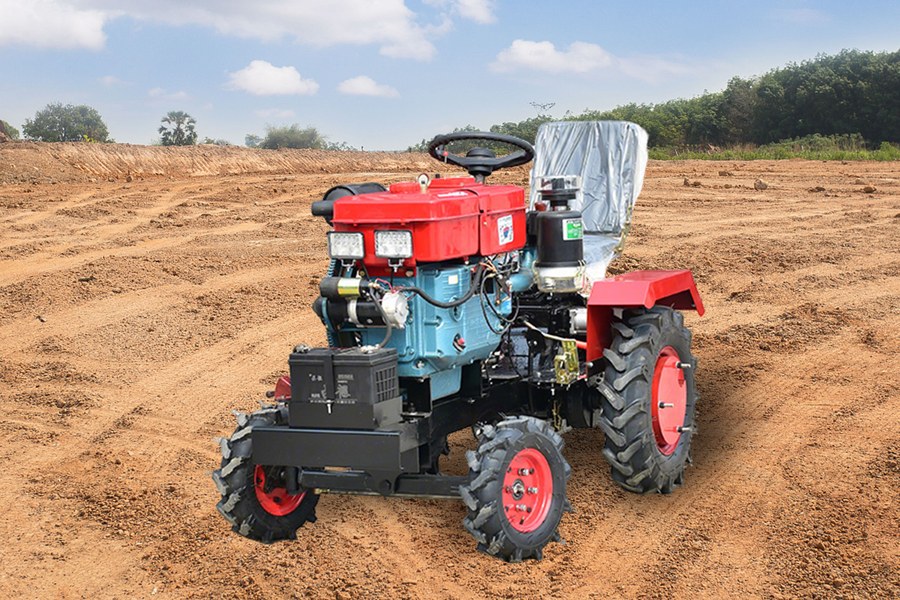
Crawler tractors and wheeled tractors have obvious differences in structural design, performance characteristics, which also leads to their different use scenarios. The following is a detailed introduction to the differences in the use scenarios and the selection of models:
1: Characteristics and application scenarios of crawler tractors:
Core features:
Large grounding area: large contact area between the tracks and the ground, small pressure per unit area (usually 0.05-0.15MPa), not easy to sink, suitable for soft or muddy ground.
Strong traction power: the friction between the tracks and the ground is large, and the traction power is usually 30%-50% higher than that of wheeled tractor with the same power, which is suitable for heavy load operation.
High stability: with low center of gravity and wide track support surface, it is not easy to roll over when working on sloping or uneven ground.
Less damage to soil: the track crushes the soil to form shallow grooves, and the compaction is uniform, which is suitable for operations requiring high soil protection (such as rice paddies).
Applicable scenarios:
Paddy field / wet field: such as rice planting area, wheeled tractor is easy to slip and get stuck in muddy fields, while crawler tractor can work stably.
Heavy duty plowing: deep plowing, deep loosening, land clearing, and other scenarios that require large traction power (e.g., reclaiming wasteland, breaking up hard soil layers).
Forestry / Mountain work: Transportation of timber in mountainous areas, land preparation on steep slopes, etc., where tracks have a significant advantage in terms of grip and stability.
Engineering/Special Scenarios: Traction and bulldozing operations in extreme environments such as swamps and snow (e.g. water conservancy projects, snow rescue).
2: Characteristics and application scenarios of wheeled tractors
Core features:
Fast driving speed: the road driving speed can reach 20-40km/h, suitable for long-distance transfer or transportation operations.
Flexible maneuverability: small steering radius (some models are equipped with four-wheel steering), suitable for small farmland or complex field operations.
Diversified types of operation: it can be matched with a variety of agricultural implements (such as rotary tiller, seeder, harvester, etc.), with strong versatility.
Low maintenance cost: relatively simple structure, easy tire replacement and maintenance, suitable for high-frequency and multi-scene operations.
Applicable Scenarios:
Dryland / Mature Land: such as wheat and corn planting areas, where the ground is hard and the wheeled tractor has low driving resistance and high efficiency.
Sowing/plowing/harvesting: For delicate work that requires frequent changes of implements, the flexibility of wheeled tractors is more advantageous.
Transportation and road work: Transportation of agricultural materials and products in the field, or short-distance road transportation (e.g. with trailers).
Horticulture/facility agriculture: greenhouses, orchards and other space-constrained scenarios, narrow wheelbase models can travel flexibly.
3: Scenario Selection Guide: How to Choose a Model Based on Your Needs
1. Selection according to soil conditions
Paddy field, swampy land: crawler tractor, anti-sagging, low compaction, protect soil structure
Dry field, hard land: wheeled tractor, low driving resistance, high working efficiency
Sandy land / loose land: crawler tractor, reduce tire slippage, improve traction
2. Selection according to type of work
Heavy duty tillage (deep ploughing, clearing): give preference to crawler tractor, with high traction power and less damage to the soil.
For light/medium duty work such as seeding, plowing, harvesting, etc.: choose wheeled tractors for better flexibility and versatility.
Transportation (road or field): wheeled tractors are fast and easy to transfer, and if the load is very heavy, you can consider tracked (e.g. forestry timber transportation).
3. Selection according to terrain and environment
Mountainous areas and steep slopes: tracked tractors are stable and prevent the risk of rollover.
Plains, small farmland: wheeled tractor with flexible steering, suitable for small plot shuttle.
Extreme climate (snow, wetland): tracked tractor has better passability.
4. Selection according to economy and maintenance needs
Short-term / small-area operation: wheeled tractor is more cost-effective due to low acquisition cost and simple maintenance.
Long-term / large-scale heavy-duty operation: tracked tractor durability, long-term use of cost is more controllable (need to pay attention to the cost of track wear and replacement).
4: Additional recommendations for special scenarios
Dual-use requirements: If you need to combine water and dryland operations, you can consider track-wheel interchangeable models (e.g., some models support quick change of tracks and tires).
Precision agriculture and intelligence: Wheeled tractors are more easily integrated with GPS navigation and self-driving systems, which are suitable for precision operations on modern farms.
Environmental requirements: tracked tractors have low soil compaction, which is suitable for organic farms or conservation tillage scenarios; wheeled tractors need to pay attention to the adjustment of tire pressure to avoid over-compaction of the soil.
Summarize
The core logic of choosing a tractor model is: oriented by scene needs, prioritizing operational efficiency and safety, then taking into account economy and maintenance costs.
Complex terrain, heavy load, low soil damage: choose crawler tractor.
Conventional farmland, high mobility, multi-type operation needs: choose wheeled tractor.
In practice, it is necessary to make a comprehensive decision based on the local climate, crop type, plot size and budget, and if necessary, consult a dealer or agricultural technician for a customized solution.